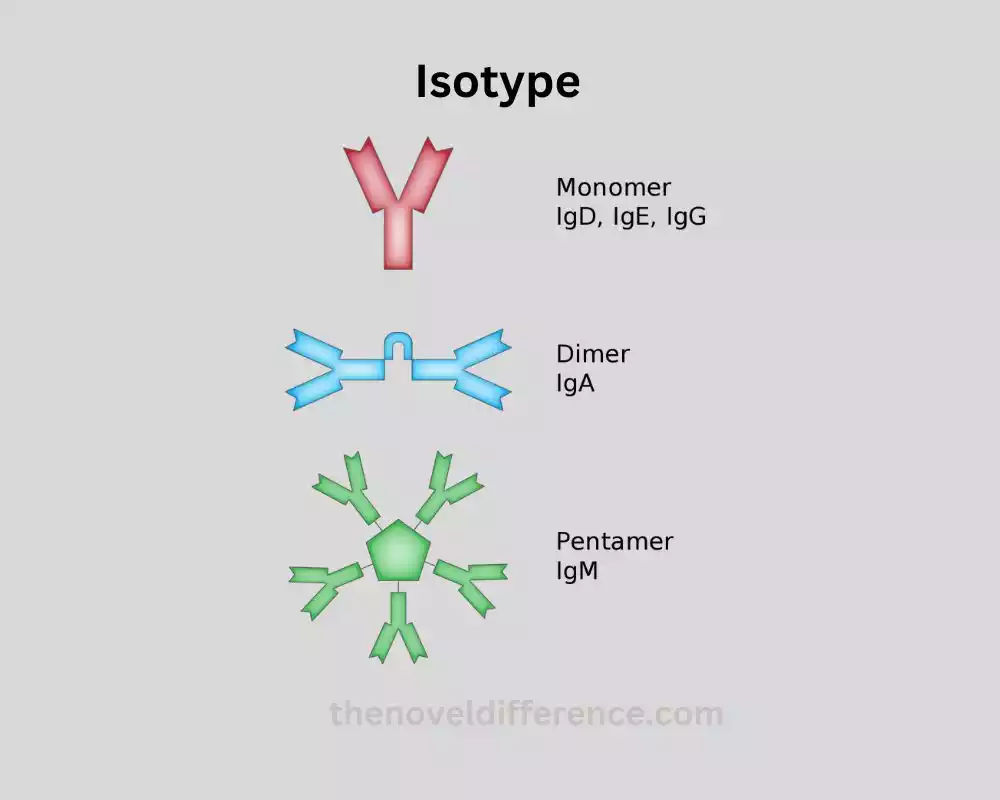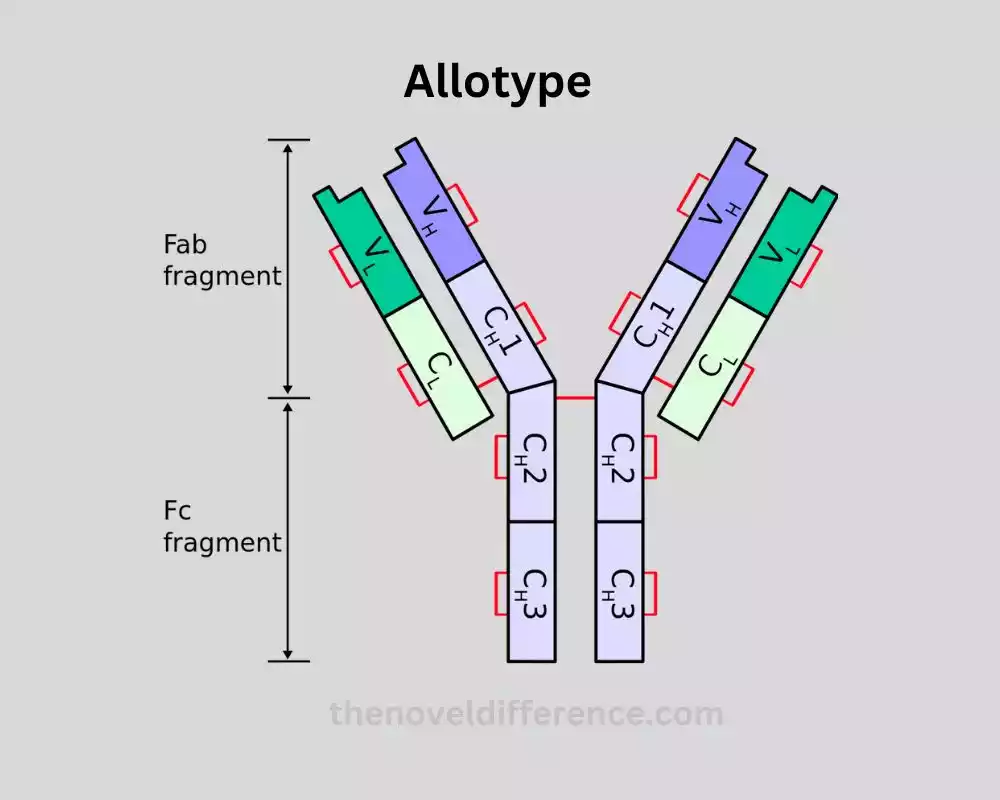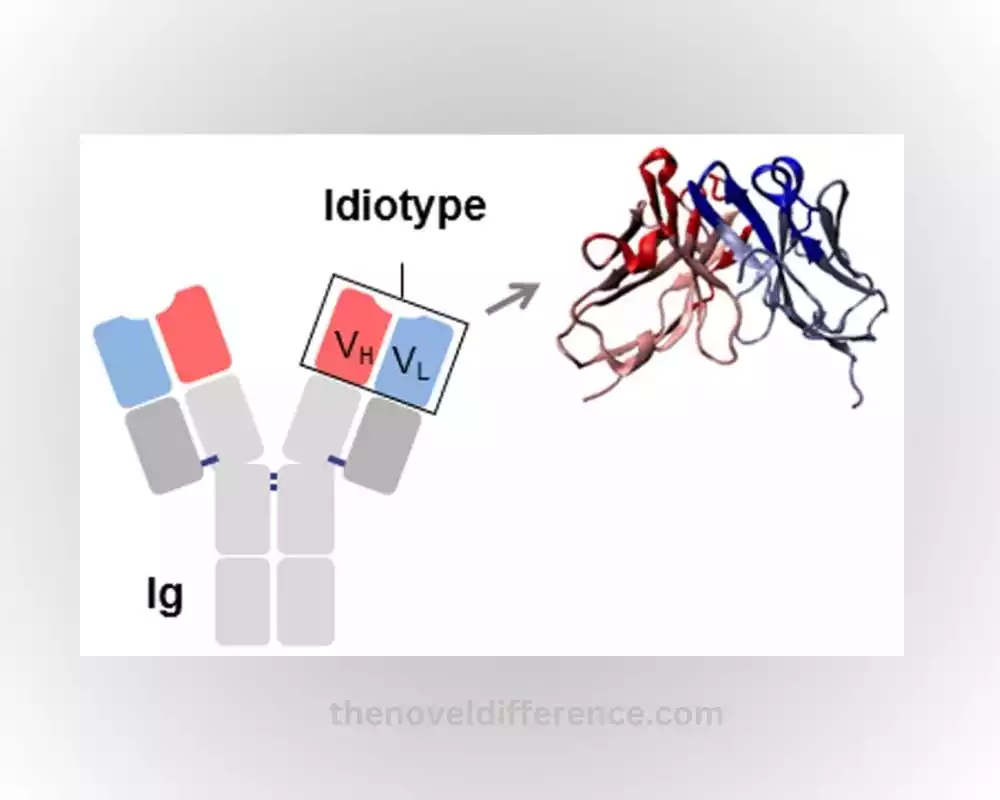Definition of Isotype Allotype and Idiotype
Isotype: Isotype is a classification system used in immunology to classify and differentiate between different classes and subclasses (Immunoglobulins), based on their structural and functional properties. Antibodies are proteins produced by B cells to counteract any foreign substances known as antigens that enter their bodies.
Isotypes are defined by the constant region of the antibody molecule, which remains the same within a particular class or subclass. The constant region determines the effector functions and distribution of antibodies in the body. Humans possess five major isotypes of antibodies: IgG, IgM, IgA, IgD, and IgE.
Each isotype has unique properties and functions:
- IgG: Immunoglobulin G is the most abundant antibody isotype in the bloodstream and tissues. It plays a crucial role in long-term immunity, opsonization (enhancing phagocytosis), neutralization of toxins, and crossing the placenta to provide passive immunity to newborns.
- IgM: Immunoglobulin M is the first antibody produced during an initial immune response. It is present primarily in the bloodstream and plays a role in complement activation and agglutination of antigens.
- IgA: Immunoglobulin A is found predominantly in mucosal areas such as the respiratory and gastrointestinal tracts, as well as in secretions like saliva, tears, and breast milk. It provides localized immunity by neutralizing pathogens at mucosal surfaces.
- IgD: Immunoglobulin D is present in small amounts on the surface of mature B cells. Its precise function is not fully understood, but it is believed to be involved in the activation and differentiation of B cells.
- IgE: Immunoglobulin E is involved in allergic reactions and defense against parasitic infections. It triggers the release of histamine and other chemicals from mast cells and basophils, leading to allergic symptoms.
Isotypes play crucial roles in immune responses, each contributing to specific defense mechanisms and providing a diverse range of protection against various pathogens and antigens.
Allotype: Allotype refers to genetic variations or polymorphisms within the constant region of antibodies (immunoglobulins) present among individuals of the same species. These genetic variations occur naturally and are inherited.
Allotypes are specific amino acid sequence differences within the constant region of antibodies, resulting from genetic variations in the genes encoding the antibody’s heavy or light chains.
These variations can occur at specific positions within the constant region, leading to differences in the antibody’s structure and function.
The presence of allotypes can be detected by serological or genetic techniques. Serological methods involve using antibodies specific to different allotypes to identify their company in an individual’s serum.
Genetic methods, such as DNA sequencing or restriction fragment length polymorphism (RFLP) analysis, can directly analyze the DNA sequence and identify the presence of specific allotypes.
Allotypes are often used as genetic markers for studying population genetics, evolutionary relationships, and inheritance patterns. They can also have implications in transplantation and immunotherapy.
For example, in transplantation, matching the donor and recipient allotypes can reduce the risk of graft rejection.
It is important to note that not all antibody isotypes have allotypes. The presence of allotypes is more commonly observed in certain antibody isotypes, such as IgG and IgA, compared to others like IgM or IgE.
Allotype refers to genetic variations within the constant region of antibodies, resulting in differences in the structure and function of the antibodies. These variations can serve as genetic markers and have implications in various areas of immunology and genetics.
Idiotype: Idiotype refers to the unique set of antigenic determinants or epitopes present on the variable region of an antibody. It represents the specific binding site of an antibody that recognizes and interacts with a particular antigen.
The variable region of an antibody is composed of two segments: the variable heavy chain (VH) and the variable light chain (VL). These segments form a three-dimensional structure that creates the antigen-binding site, which is specific to a particular antigen.
The idiotype of an antibody is determined by the amino acid sequence within the variable region. It encompasses the complementarity-determining regions (CDRs) that directly interact with the antigen and contribute to antigen recognition and binding specificity.
Since each antibody produced by B cells is generated through a process of genetic recombination and somatic hypermutation, the idiotype of an antibody is unique to that specific antibody. This means that each antibody has its own characteristic idiotype, which distinguishes it from other antibodies.
The idiotype can also be categorized into three subcategories:
- Idiotypic specificity: Refers to the unique antigenic determinants present on the variable region of the antibody, which determine its specificity for a particular antigen.
- Anti-idiotypic antibodies: These are antibodies that recognize and bind to the idiotype of another antibody. Anti-idiotypic antibodies can mimic the structure of an antigen and can be used in various applications, such as blocking or modulating immune responses.
- Idiotypic network: Refers to the complex interplay between antibodies and their anti-idiotypic antibodies. The idiotype-anti-idiotype interactions can regulate the immune response, influencing antibody production and immune system function.
The idiotype of an antibody is crucial for antigen recognition and the initiation of immune responses. It plays a significant role in antibody diversity, immune surveillance, and the ability of the immune system to generate specific responses against a wide range of antigens.
Idiotype refers to the unique set of antigenic determinants present on the variable region of an antibody. It determines the specificity and binding characteristics of the antibody and plays a vital role in immune recognition and response.
Importance of understanding the differences between these terms
Understanding the differences between isotype, allotype, and idiotype is essential in the field of immunology for several reasons:
- Accurate Communication: Clear understanding and correct usage of these terms allow effective communication among researchers, clinicians, and immunologists. It ensures that discussions and findings related to antibodies and immune responses are accurately conveyed and understood.
- Immunological Research: Understanding the differences between these terms helps researchers design experiments and studies to investigate various aspects of immune responses. It allows for precise characterization and classification of antibodies, leading to a better understanding of immune mechanisms, disease pathogenesis, and potential therapeutic interventions.
- Clinical Applications: Differentiating between isotype, allotype, and idiotype is crucial in clinical settings. Knowledge of isotypes aids in interpreting antibody function, assessing immune status, and monitoring responses to infections or immunizations. Allotypes can be relevant in transplantation, as matching allotypes between donor and recipient can help reduce the risk of graft rejection. Idiotype-targeted therapies rely on a deep understanding of idiotype-specific antibodies for the treatment of certain cancers and autoimmune disorders.
- Vaccine Development: Understanding isotypes helps in designing effective vaccines. Different isotypes play unique roles in immune responses, and knowledge of their characteristics helps researchers choose appropriate antigens and adjuvants to stimulate specific immune pathways and generate desired immune responses.
- Antibody-Based Therapies: Knowledge of idiotype is crucial in the development and use of antibody-based therapies. Monoclonal antibodies with specific idiotype can be engineered or selected to target specific antigens or immune pathways. Understanding idiotype variability allows for the design of personalized therapeutic approaches and the monitoring of treatment responses.
- Genetic and Population Studies: Differentiating between allotypes is essential for genetic and population studies. Allotype frequencies can vary among populations and can serve as genetic markers for studying genetic diversity, evolution, and population migrations.
Understanding the differences between isotype, allotype, and idiotype is fundamental for accurate communication, immunological research, clinical applications, vaccine development, antibody-based therapies, and genetic studies.
It ensures the precise characterization of antibodies, accurate interpretation of immune responses, and advancement in immunological knowledge and applications.
What is Isotype?
Isotype refers to a classification system used in immunology to categorize and distinguish different classes or subclasses of antibodies (immunoglobulins) based on their structural and functional characteristics.
Antibodies are proteins produced by B cells in response to the presence of foreign substances, known as antigens, in the body.
Isotypes are defined by the constant region of the antibody molecule, which remains the same within a particular class or subclass.
The constant region determines the effector functions and distribution of antibodies in the body. There are five major isotypes of antibodies in humans: IgG, IgM, IgA, IgD, and IgE.
Each isotype has unique properties and functions:
- IgG: Immunoglobulin G is the most abundant antibody isotype in the bloodstream and tissues. It plays a crucial role in long-term immunity, opsonization (enhancing phagocytosis), neutralization of toxins, and crossing the placenta to provide passive immunity to newborns.
- IgM: Immunoglobulin M is the first antibody produced during an initial immune response. It is present primarily in the bloodstream and plays a role in complement activation and agglutination of antigens.
- IgA: Immunoglobulin A is found predominantly in mucosal areas such as the respiratory and gastrointestinal tracts, as well as in secretions like saliva, tears, and breast milk. It provides localized immunity by neutralizing pathogens at mucosal surfaces.
- IgD: Immunoglobulin D is present in small amounts on the surface of mature B cells. Its precise function is not fully understood, but it is believed to be involved in the activation and differentiation of B cells.
- IgE: Immunoglobulin E is involved in allergic reactions and defense against parasitic infections. It triggers the release of histamine and other chemicals from mast cells and basophils, leading to allergic symptoms.

Isotypes play crucial roles in immune responses, each contributing to specific defense mechanisms and providing a diverse range of protection against various pathogens and antigens.
What is Allotype?
Allotype refers to genetic variations or polymorphisms within the constant region of antibodies (immunoglobulins) present among individuals of the same species. These genetic variations occur naturally and are inherited.
Allotypes are specific amino acid sequence differences within the constant region of antibodies, resulting from genetic variations in the genes encoding the antibody’s heavy or light chains. These variations can occur at specific positions within the constant region, leading to differences in the antibody’s structure and function.
The presence of allotypes can be detected by serological or genetic techniques. Serological methods involve using antibodies specific to different allotypes to identify their company in an individual’s serum.
Genetic methods, such as DNA sequencing or restriction fragment length polymorphism (RFLP) analysis, can directly analyze the DNA sequence and identify the presence of specific allotypes.
Allotypes are often used as genetic markers for studying population genetics, evolutionary relationships, and inheritance patterns. They can also have implications in transplantation and immunotherapy.
For example, in transplantation, matching the donor and recipient allotypes can reduce the risk of graft rejection.
It is important to note that not all antibody isotypes have allotypes. The presence of allotypes is more commonly observed in certain antibody isotypes, such as IgG and IgA, compared to others like IgM or IgE.

Allotype refers to genetic variations within the constant region of antibodies, resulting in differences in the structure and function of the antibodies. These variations can serve as genetic markers and have implications in various areas of immunology and genetics.
What is Idiotype?
Idiotype refers to the unique set of antigenic determinants or epitopes present on the variable region of an antibody. It represents the specific binding site of an antibody that recognizes and interacts with a particular antigen.
The variable region of an antibody is composed of two segments: the variable heavy chain (VH) and the variable light chain (VL). These segments form a three-dimensional structure that creates the antigen-binding site, which is specific to a particular antigen.
The idiotype of an antibody is determined by the amino acid sequence within the variable region. It encompasses the complementarity-determining regions (CDRs) that directly interact with the antigen and contribute to antigen recognition and binding specificity.
Since each antibody produced by B cells is generated through a process of genetic recombination and somatic hypermutation, the idiotype of an antibody is unique to that specific antibody. This means that each antibody has its own characteristic idiotype, which distinguishes it from other antibodies.
The idiotype can also be categorized into three subcategories:
- Idiotypic specificity: Refers to the unique antigenic determinants present on the variable region of the antibody, which determine its specificity for a particular antigen.
- Anti-idiotypic antibodies: These are antibodies that recognize and bind to the idiotype of another antibody. Anti-idiotypic antibodies can mimic the structure of an antigen and can be used in various applications, such as blocking or modulating immune responses.
- Idiotypic network: Refers to the complex interplay between antibodies and their anti-idiotypic antibodies. The idiotype-anti-idiotype interactions can regulate the immune response, influencing antibody production and immune system function.
The idiotype of an antibody is crucial for antigen recognition and the initiation of immune responses. It plays a significant role in antibody diversity, immune surveillance, and the ability of the immune system to generate specific responses against a wide range of antigens.

In summary, idiotype refers to the unique set of antigenic determinants present in the variable region of an antibody. It determines the specificity and binding characteristics of the antibody and plays a vital role in immune recognition and response.
Differences between Isotype, Allotype, and Idiotype
To clarify the distinctions between isotype, allotype, and idiotype, let’s examine their differences:
- Isotype:
-
- Definition: Isotype refers to different classes or subclasses of antibodies, categorized based on their structural and functional characteristics.
- Basis: Isotypes are determined by the constant region of the antibody molecule.
- Examples: IgG, IgM, IgA, IgD, and IgE.
- Function: Isotypes contribute to specific defense mechanisms and provide diverse protection against various antigens.
- Allotype:
-
- Definition: Allotype refers to genetic variations or polymorphisms within the constant region of antibodies, present among individuals of the same species.
- Basis: Allotypes result from genetic variations in the genes encoding antibody heavy or light chains.
- Detection: Allotypes can be identified using serological or genetic techniques.
- Significance: Allotypes are used as genetic markers for studying population genetics, evolutionary relationships, and transplantation compatibility.
- Idiotype:
-
- Definition: Idiotype refers to the unique set of antigenic determinants or epitopes present on the variable region of an antibody.
- Basis: Idiotype is determined by the amino acid sequence within the variable region.
- Function: Idiotype determines the specificity and binding characteristics of an antibody, enabling recognition and interaction with a particular antigen.
- Types: Idiotypes can be categorized into idiotype-specific epitopes, anti-idiotypic antibodies, and the complex network of idiotype-anti-idiotype interactions.
Isotype refers to different classes or subclasses of antibodies based on their structural and functional characteristics. Allotype represents genetic variations within the constant region of antibodies among individuals of the same species.
Idiotype pertains to the unique antigenic determinants on the variable region of an antibody, determining its specificity and interaction with a specific antigen.
What are the Similarities Between Isotype Allotype and Idiotype?
While isotype, allotype, and idiotype have distinct meanings and characteristics, there are some similarities between these terms:
- Antibody-related Terminology: All three terms are used in the context of antibodies (immunoglobulins) and are relevant to the field of immunology.
- Variations within Antibodies: Isotype, allotype, and idiotype all involve variations within the structure or function of antibodies.
- Genetic Basis: Isotype, allotype, and idiotype are influenced by genetic factors. They result from genetic variations in the genes
encoding antibody chains (for allotype) or the variable region of the antibody (for idiotype). - Impact on Immune Response: Isotype, allotype, and idiotype can have implications for immune responses and antibody functionality. They contribute to antibody diversity and play roles in antigen recognition, binding specificity, and immune system function.
- Immunological Relevance: Understanding the distinctions and relationships between isotype, allotype, and idiotype is important for immunological research, clinical applications, and therapeutic interventions.
- Classification Systems: Isotype, allotype, and idiotype are classification systems or concepts used to categorize and differentiate antibodies based on specific criteria (e.g., structural characteristics, genetic variations, antigenic determinants).
While they share these similarities, it is crucial to note that isotype, allotype, and idiotype are distinct concepts with unique implications and applications in immunology.
Isotype vs Allotype vs Idiotype in Tabular Form
Certainly! Here’s a tabular representation highlighting the key differences between isotype, allotype, and idiotype:
| Aspect | Isotype | Allotype | Idiotype |
| Definition | Different classes or subclasses of antibodies based on structural and functional characteristics | Genetic variations within the constant region of antibodies among individuals of the same species | A unique set of antigenic determinants on the variable region of an antibody |
| Basis | The constant region of the antibody molecule | Genetic variations in the genes encoding antibody chains | The amino acid sequence within the variable region |
| Examples | IgG, IgM, IgA, IgD, IgE | Specific variations within an isotype (e.g., different forms of IgG) | Unique to each individual antibody |
| Detection | N/A | Serological or genetic techniques | N/A |
| Function | Determines effector functions and distribution of antibodies | Genetic markers for studying population genetics and transplantation compatibility | Determines specificity and binding characteristics of an antibody |
| Importance | Classifies antibodies based on their properties | Helps study genetic diversity and inheritance patterns | Essential for antigen recognition and interaction |
This tabular representation outlines the primary distinctions between isotype, allotype, and idiotype, emphasizing their definitions, basis, examples, detection methods, functions, and significance.
Conclusion
Understanding the differences between isotype, allotype, and idiotype is crucial in the field of immunology. Each term represents a distinct aspect of antibodies and plays a significant role in immune responses and antibody functionality.
Isotype refers to different classes or subclasses of antibodies based on their structural and functional characteristics, determining their effector functions and distribution within the body.
Allotype represents genetic variations within the constant region of antibodies among individuals of the same species. It serves as a genetic marker for population genetics, evolutionary studies, and transplantation compatibility.
